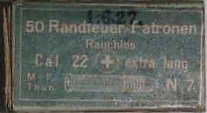Hi,
I'm sure a lot of you are familiar with the Sharpshooter 22 Reloader tool. Something that's new is their Prime-All priming compound to spare the grief of making our own from match heads or cap gun caps.
Prime-All Repriming Compound ? Sharpshooter 22LR Reloader
Problem is, this stuff is out of stock!
There are four powder chemicals in the kit.
Anyone have any idea what these chemicals might be?
Thanks,
Jim
I'm sure a lot of you are familiar with the Sharpshooter 22 Reloader tool. Something that's new is their Prime-All priming compound to spare the grief of making our own from match heads or cap gun caps.
Prime-All Repriming Compound ? Sharpshooter 22LR Reloader
Problem is, this stuff is out of stock!
There are four powder chemicals in the kit.
Anyone have any idea what these chemicals might be?
Thanks,
Jim

